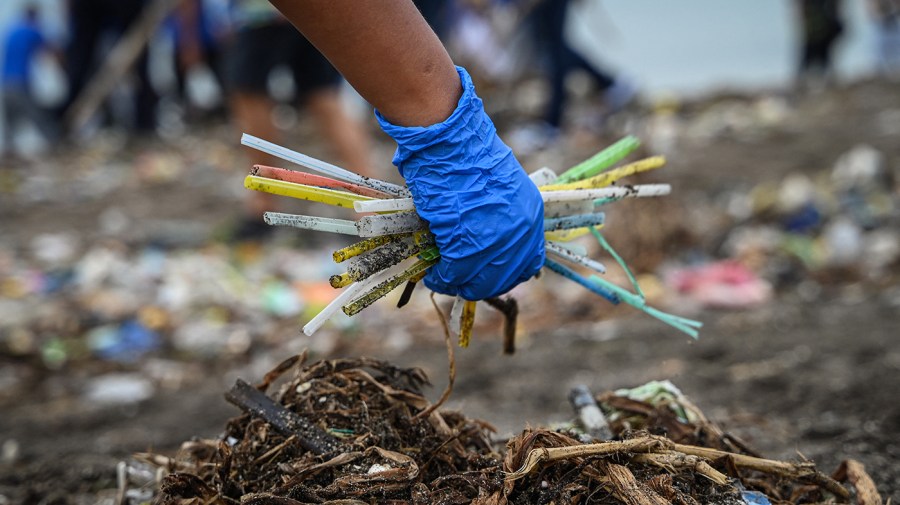
Paper straws are, objectively, the worst.
There’s the race against the clock to use them before they turn to mush, the temperature problem — good for neither hot nor frozen — and, worst of all, the appalling sensation when they make contact with your teeth.
We live in an age of miracles and wonders for the straw sector, though. They’re making disposable straws out of cornstarch (better but brittle), gluten (allergy alert), biodegradable plastic (pricey and some temperature problems) and even straws made out of straw (meta, dude). The food service industry, a $1.5 trillion behemoth, is very much thinking about how to get liquids to your lips. If they could figure out how to swallow for you, they’d do that too. Baja Blast Injectable could be just around the corner …
The reason for this sprint into the future of sipping is in part a matter of consumer preferences. As Americans have become more concerned about plastic waste, particularly what ends up in the ocean, retailers have responded with alternatives. And though the claims on which the initial, ahem, wave of concern were based turned out to be quite dubious, even sensible people might not want to take the chance of a sea turtle ending up with a Mickey D’s straw up her left nostril. Aside from those who have physical limitations, most people only use straws when they’re dining out, so a different experience or slightly higher cost may seem a reasonable sacrifice to many.
Then there’s compulsion. An increasing number of states and municipalities have banned plastic drinking straws. California led the way and continues to crack down on single-use plastics. This blue-state move has led to a red-state backlash in which Republican lawmakers have pursued bans on bans. Plastic straws took on a totemic quality for right-wingers who saw the bans as further evidence of government overreach and the nanny state run amok. It’s been a whole thing.
Wherever there is a controversy, you can count on enterprising Americans to find profit. The winners of the straw wars have been those who have figured out how to develop alternatives to old-fashioned plastic straws that avoid the soggy miseries of paper. If, 20 years ago, you would have told the people now making millions from using the marvels of material science to make drinking straws that their fortune lay in the bottom of a frappuccino cup they probably wouldn’t have believed you.
As this was playing out over the past decade, the question of whether the federal government would get involved hovered over what had gone from environmental concern to culture war hot zone. Progressives wanted urgent federal action on what was just one part of a “crisis for human health and the environment” driven by the use of plastics. But given the hardening opposition to soft straws, Congress was unlikely to produce a law.
Then-President Biden took, what else, executive action in 2024 and initiated a program to ban single-use plastic in federal food service by 2027, with a total ban across the federal government by 2035.
This was, to Biden’s critics on the left, small beer. Activists like Robert F. Kennedy Jr., then still a crusading environmentalist, and others decried Biden’s efforts on plastic as insufficient, demanding greater presidential leadership to move toward a global treaty restricting plastics and a domestic regulatory crackdown on the industry.
But what Biden did was not a small thing.
The federal government, as we all know, spends a great deal of money. The biggest part of that money goes out as, well, money: Transfer payments for entitlements and welfare programs and aid to states. Nearly two-thirds of the $6.7 trillion ladled out by Uncle Sam is in the form of direct payments.
But the federal government also buys a lot of goods, something like $871 billion in 2023, more than half of which was spent on stuff for the military.
Plastics straws, utensils and bags didn’t make up a great deal of that $871 billion, but enough to make the U.S. government one of the largest buyers of consumer goods in the entire world. A change in federal purchasing policies has implications for everyone. If a company is or wants to be a government contractor, prudence would dictate that they bring their product line into accord with federal purchasing policy. Goodbye plastic forks, hello bamboo sporks.
On Friday, Trump gave word that he was ready to reverse course, saying on social media, “I will be signing an Executive Order next week ending the ridiculous Biden push for Paper Straws, which don’t work. BACK TO PLASTIC!” and a more evocative follow up: “Enjoy your next drink without a straw that disgustingly dissolves in your mouth!!!”
Now this is where Trumpology gets tricky. Having not seen the promised order, it may be less than it appears. It’s possible that Trump will just rescind Biden’s actions and allow agencies to go back to the way things were before. If the Park Service wants to reduce litter and use biodegradable products, fine. If the Pentagon needs durable, cheap plastic straws, that’s fine, too.
Or maybe Trump means what he says and will require the government to only use plastic straws and will standardize federal purchases to meet a very specific, plastic-y requirement. Trump could use federal spending to shape the choices Americans have in their private lives.
The straw showdown is a pretty useful metaphor for the big question hanging over Washington these days: Does Trump wish to undo Biden or outdo Biden?
Looking at the way the Justice Department aims to use civil rights to target private employers who favor diversity hiring initiatives or the FCC’s move to crack down on left-wing speech, it would seem like the latter. After four years in which the regulatory state was employed for progressive social engineering, it seems like the right-wingers are ready to take their turn.












